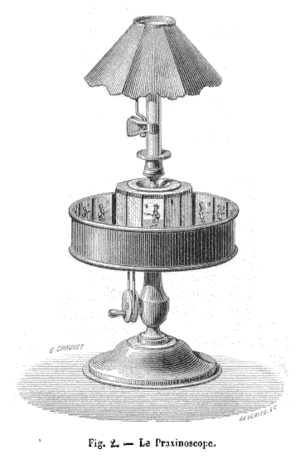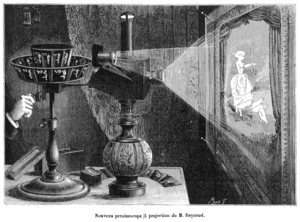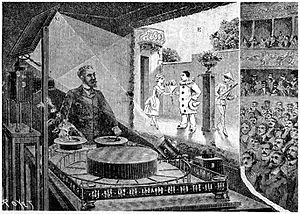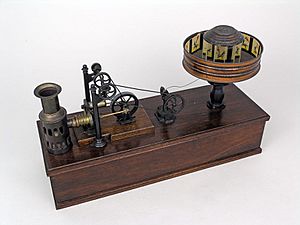Praxinoscope facts for kids
The praxinoscope was a cool device used to create animation. It was like an improved version of an older toy called the zoetrope. A French inventor named Charles-Émile Reynaud created it in 1877.
Just like the zoetrope, the praxinoscope used a strip of pictures. These pictures were placed around the inside of a spinning cylinder. The big improvement was how you watched it. Instead of tiny slits, the praxinoscope had a circle of mirrors inside.
These mirrors were set up so that the pictures looked still as the cylinder spun. When you looked into the mirrors, you saw the pictures flash by very quickly. This made it look like the images were moving! The praxinoscope also gave a brighter and clearer picture than the zoetrope.
Contents
Types of Praxinoscopes
Charles-Émile Reynaud made several different versions of his praxinoscope. Each one added new and exciting ways to enjoy animation.
The Praxinoscope-Théâtre
In 1879, Reynaud introduced the Praxinoscope-Théâtre. This version was hidden inside a special box. The idea was to make the moving figures look like they were part of a tiny stage play.
When you set it up, you looked through a slot in the front of the box. Inside, there was a clear mirror surrounded by a printed stage opening, like a mini proscenium. This mirror reflected a background and a floor. These were printed on cards placed inside the box's lid.
The animated figures themselves were printed on black strips. This made them almost invisible except for the moving parts. They appeared to move within the reflected background, creating a magical scene. This version came with 20 animation strips and 12 different backgrounds. It was very popular and even had a fancy deluxe version made of special wood.
Projecting Praxinoscopes
Reynaud also thought about projecting his animations onto a screen. He mentioned this idea in his first patent in 1877. By 1880, he showed a projecting praxinoscope device. However, he didn't start selling his praxinoscope a projection until 1882. Today, only a few of these special devices still exist.
The Théâtre Optique
In 1888, Reynaud created an even more advanced machine called the Théâtre Optique. This was a huge step forward! It could project images onto a large screen. It used a much longer roll of pictures, allowing for longer stories.
Starting in 1892, Reynaud used the Théâtre Optique for his Pantomimes lumineuses. These were shows with hand-drawn animated stories for big audiences. They were very successful for several years. However, their popularity eventually faded when the Lumière brothers invented their photographic film projector.
Other companies also copied the praxinoscope. For example, Ernst Plank made several versions. One of his models, called the kinematofor, was even powered by a small hot air engine.
Modern Praxinoscope Ideas
The praxinoscope's idea of using mirrors for animation was brought back in the 20th century.
The Red Raven Magic Mirror
In 1956, the Red Raven Magic Mirror was introduced in the United States. It came with special children's phonograph records. The Magic Mirror was a reflector with sixteen angled sides. You placed it over the record player's spindle, and it spun with the 78 rpm record.
The record had a very large label with sixteen animation pictures arranged around its center. As the music played, you looked into the Magic Mirror. You would see an endlessly repeating animated scene that showed what the song was about. In the 1960s, similar systems appeared in Europe and Japan. They had different names like Teddy in France and Mamil Moviton in Italy.
What Does "Praxinoscope" Mean?
The word "praxinoscope" roughly means "action viewer." It comes from two Greek words. The first part, praxi-, comes from πρᾶξις (praxis), which means "action." The second part, scop-, comes from σκοπός (skopos), meaning "watcher" or "viewer." So, it's a device for watching action!
See also
 In Spanish: Praxinoscopio para niños
In Spanish: Praxinoscopio para niños





